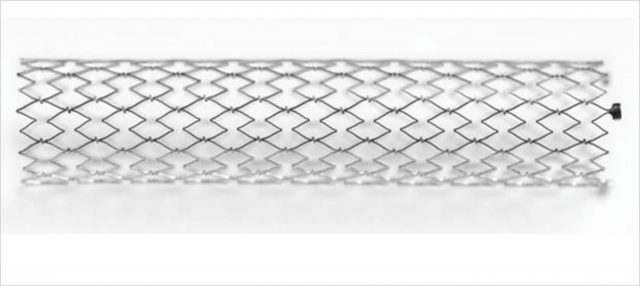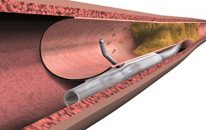Courtesy of Dr. Carlos Fava. Severe atherosclerotic disease in iliac arteries is experienced by 15% of all men and 5% of all women. TAC II recommends angioplasty for type-A, -B, and -C lesions. As regards stent type, self-expanding stent (SE, more elasticity) vs. balloon-expandable stent (SB, more radial strength), Reekers indicates superior target lesion revascularization (TLR) with SE. However, there…
VALIDATE-SWEDEHEART: bivalirudin seems to be losing ground
Another important work that does not see the benefits of bivalirudin over heparin as monotherapy as regards both efficacy (death and MI) and safety end points (bleeding) in patients undergoing acute myocardial infarction with and without ST elevation. The study VALIDATE-SWEDEHEART, presented at ESC, simultaneously published in the New England Journal of Medicine, randomized 6000 patients…
Early Invasive Strategy Benefits High-Risk Patients
Early angiography is not associated with a reduction in mortality compared with a more delayed invasive strategy in patients with non-ST-elevation acute coronary syndrome (NSTE-ACS). However, a new meta-analysis published by The Lancet supports the idea that certain high-risk patients would benefit from it. Patients with elevated cardiac biomarkers, a high GRACE score, diabetes, or advanced…
Striking Finding on Diabetes and Bypass Graft Patency
The higher rate of restenosis in the diabetic population is historic and has been reproduced in all studies and with all kinds of stents, but it was only after the FREEDOM trial when we found out about the higher infarction rate with PCI compared to surgery. This is why 50% of patients undergoing CABG are diabetic. Apart from the above…
Should We Begin to Use IVUS in CTO?
Courtesy of Dr. Carlos Fava. Currently, chronic total occlusions (CTO) are one of the obstacles that coronary angioplasties must overcome, particularly with the development of drug-eluting stents (DES) and new devices and strategies for these challenging lesions. However, there is little information on the safety, efficacy, and real clinical benefit of implanting stents of over 60 mm (known as full metal jackets, FMJ).…
Nicaragua Sessions: Contest for Young Interventionists
Sponsored by Abbott Vascular LATAM 33rd SOLACI Regional Sessions – 12° Central America and the Caribbean Regional Meeting September 29th and 30th, 2017. Managua, Nicaragua. Case Submission: “Fostering Hemodynamics among Young Cardiologists”. It is with great pleasure that we hereby invite all young Latin American cardiologists specializing in hemodynamics to submit relevant clinical cases to the…
Are Bioresorbable-Polymer Stents More Thrombogenic than Durable-Polymer Second-Generation Stents?
Courtesy of Dr. Cristian Jesús Rodríguez. Most stents currently used in percutaneous coronary intervention (PCI) are durable-polymer second-generation drug-eluting stents (DP-DES, with everolimus or zotarolimus). However, it has been argued that the persistence of such a polymer after complete drug elution is one of the main factors for a dangerous complication: stent thrombosis (ST). After…
Risk of Thrombosis and Bleeding with Peripheral Artery Disease and Concomitants
Peripheral artery disease (PAD) is no longer a systemic manifestation of atherosclerosis. In fact, 2 in 3 people with PAD have concomitant heart disease, and 1 in 3 people has concomitant PAD. To understand the real dimension of this problem, we should know that PAD patients have 60% more risk of acute myocardial infarction…
Incomplete Revascularization Is Associated with Mortality in TAVR
Courtesy of Dr. Carlos Fava. TAVR has proven to be beneficial for inoperable and high-risk patients, as well as for intermediate-risk patients. However, while many comorbidities have been analyzed, the presence, severity, and impact of coronary disease has not been well studied yet. This study analyzed 1270 patients who underwent TAVR. They presented >50% lesions in a major epicardial…
SOLACI CACI 2017 | Re-entry approach to CTO
Read articles on the main presentations of the third day of SOLACI-CACI 2017 Congress. See the presentation by Dr. Luiz Fernando Ybarra, entitled “Re-entry approach to CTO”. We are interested in your opinion. Please, leave your comments, thoughts, questions, etc., below. They will be most welcome.
SOLACI CACI 2017 | Is the PCI risk higher in patients with severe Aortic Stenosis? How can we reduce the risk?
Read articles on the main presentations of the third day of SOLACI-CACI 2017 Congress. See the presentation by Dr. Daniel Weilenmann, entitled “Is the PCI risk higher in patients with severe Aortic Stenosis? How can we reduce the risk?“. We are interested in your opinion. Please, leave your comments, thoughts, questions, etc., below. They will be most welcome.










